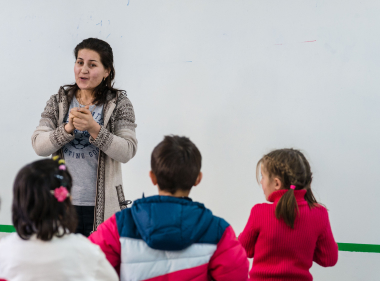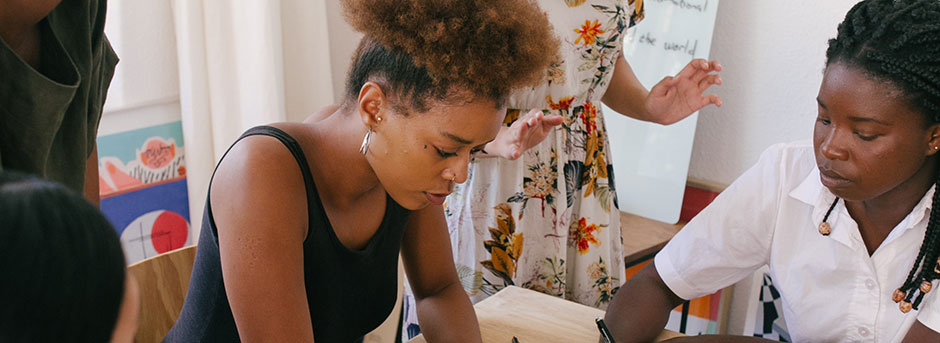Human-Centered Design
Every day, teachers create experiences for their students through developing student goals, considering different student needs, iterating between lessons, and impacting student learning outcomes.
We believe that empowering educators with foundational design tools and methods will not only amplify the work they currently do, but it will also amplify the learning potential of their students.

The goal of the second step of the Schools2030 programme model is to empower teachers to design new solutions to improve holistic learning outcomes. In order to support that step, we have developed a customized Human-Centered Design process that is supported through a toolkit as well as a process for training participants in the process.
Our hope is that anyone who picks up the Schools2030 Human-Centered Design Educators Toolkit can go through it, page by page, to complete a locally-driven design process with fidelity. They can use this toolkit to create human-centered projects that will improve the holistic learning outcomes of their students.
WHAT IS HUMAN-CENTERED DESIGN?
The foundationof human-centered designis a first-hand understandingof the human needs andbehaviors in the systems being designed, followed bydecision-making that is basedon that understanding.
Human-centered design, a recognized approach for creating thoughtful experiences and systems, is a core practice of some of the most innovative companies and organizations in the world. Human-centered design has been utilized to create consumer products, healthcare systems, retail spaces, fundraising events, policies and procedures, curricula and more.
The foundation of human-centered design is a first-hand understanding of the human needs and behaviors in the systems being designed, followed by decision-making that is based on that understanding. It relies heavily on collaboration from a team, participation from potential end users and stakeholders, a willingness to find the solution through iterative cycles of learning, and a focus on action over planning.
Using the stakeholder-centered, iterative process of human-centered design can also provide helpful structures for designing more equitable solutions for all people, even those who are traditionally underrepresented. By creating a community-driven collaborative process that engages stakeholders in the work of co-creation and iterative feedback, human-centered design can help to identify solutions that will solve real problems and meet important (but sometimes misunderstood) needs.
HUMAN-CENTERED DESIGN IN SCHOOLS
Human-centered design methodologies have gained increasing attention in K12 education in recent years. From educators using the process as a pedagogical framework for real world, project-based learning to school leaders leveraging the process as a driver of innovation, progressive leaders of education reform around the world have taken up human-centered design as a mechanism for positive change.

As we build awareness that school systems are complex human-centered environments that are actively designed, we continue to see the desire to equip leaders and teams with tools that are used by professional designers in order to creatively solve problems and actively imagine new futures.
HUMAN-CENTERED DESIGN MINDSETS
The mindsets of human-centered design help practitioners to utilize the tools
and meet the objectives of the phases.
- Work together to understand the context
- Look carefully to understand potential problems and opportunities
- Stay optimistic that you can solve the problem
- Hold back on solving the problem until the time is right
- Get inspired by people – active listening is a source of creative inspiration
- Put aside biases and assumptions about what you think the problem is – listen to the stakeholder.
- Seek new perspectives on old problems
- See opportunities in constraints
- Get comfortable with navigating contradictory information
- Many ideas lead to good ideas
- Defer judgment and criticism of ideas until the time is right
- Idea generation is not the time for evaluating ideas
- Brainstorming is a collaborative team activity
- Allow yourself to think of wild ideas
- Prototype early and often in order to learn about your idea
- Start small to make big change
- Show don’t tell
- Many cycles of prototyping are necessary to develop an idea
- Feedback is a gift to improve your ideas
WHAT IS THE TOOLKIT?
The goal in conducting this design process for your school or classroom is to identify the root causes of the learning gaps
This toolkit is designed to support a design-based innovation process for schools participating in the Schools2030 initiative as well as any educator who decides to take on a design challenge. This process can be led by educators and school leaders, empowering them to identify problems and create solutions in response to concerns identified through the data collected with the PROMISE app and through reflection. This process is open-ended and adaptable to the cultural contexts, resource constraints and opportunities of each unique school.
The goal in conducting this design process for your school or classroom is to identify the root causes of the learning gaps for your students in order to design and test solutions that address those root causes and thus increase learning outcomes. We will be referencing the Schools2030 holistic learning outcomes as our guidelines for what learning outcomes to try to improve.
WHAT IS THE TOOLKIT?
You! Your school is embarking on this innovation process and you and your colleagues will rely on the tools in this toolkit to help you complete the needed activities for each phase of the process.
HOW WILL YOU USE THE TOOLKIT?
You will use this toolkit to guide your work throughout this design challenge. Each phase of the challenge has a section with specific tools and activities for you to complete. Though the human-centered design process is not necessarily a linear one, we recommend that you work through these activities starting at the beginning. Please do not skip any steps! There is one optional activity — Shadowing a Student — that is well labeled as such.
Although we are asking you not to skips steps, we do invite you to adapt and modify the tools to best suit your cultural context. Please work with your facilitator to make those modifications to ensure that any changes still achieve your goals for the process.
WHO IS ON THE TEAM?
Human-centered design is collaborative problem-solving process conducted by a team. It is helpful to have a diversity of backgrounds and life experiences on your design team as those different people can bring a variety of perspectives to the challenge.

Depending on how your school has decided to proceed, you will either be working in teams with your colleagues only, in regional school teams or independently to work through the tools and activities in this toolkit. Every tool in this toolkit can be completed independently. If you are working alone and you see the mention of a team, feel free to proceed on your own.
PHASES OF THE DESIGN PROCESS & WHAT IS INCLUDED
IN THE TOOLKIT
For this process, there are ten phases. Each phase has different tools or activities that you need to complete in order to move to the next phase.
Throughout the toolkit, at the beginning of each phase there is an introduction page with context and goals for the phase, as well as summaries of the tools.
At the end of each phase there is a tool to help you summarize your work and a tool to help you evaluate whether you are ready to move on and to reflect on what you have learned.